Every parent wants the best for their child—especially when it comes to safety. One of the most critical investments you’ll make in your child’s early years is a high-quality, safe baby car seat. In fact, car seats reduce the risk of fatal injury by 71% for infants and 54% for toddlers, according to the National Highway Traffic Safety Administration (NHTSA). But with dozens of brands, models, and features to consider, picking the right one can feel overwhelming.
This guide breaks down everything you need to know about choosing a safe baby car seat in 2025—covering types, safety standards, best-rated models, and installation tips. By the end, you’ll feel confident making a choice that provides comfort and, most importantly, protection.
Understanding the different types of car seats is essential for choosing the safest option for your child at every stage of their development. Car seats are not one-size-fits-all. Your child’s age, weight, and height, as well as developmental needs, play a key role in determining the appropriate seat. Let’s break down each type in detail.
Best for: Newborns to approximately 2 years old
Weight range: Typically 1.8 to 13–15 kg (4 to 30–35 lbs)
Height limit: Varies by model, but usually around 76 cm (30 inches)
Designed specifically for infants and young babies
Used in the rear-facing position only
Usually comes with a base that stays in the car while the seat clicks in and out
Compatible with many travel systems (stroller-compatible)
Has a carrying handle for easy transport
In a frontal collision, a rear-facing seat cradles the baby’s head, neck, and spine—areas that are especially vulnerable in early development. It spreads the crash forces more evenly over the back of the seat and reduces the risk of severe injuries.
Rear-facing infant seats are perfect for parents who want a lightweight, portable solution for their newborn. They’re often the first car seat a parent purchases and are typically used for the baby’s first year.
Best for: Newborns through toddlers and preschoolers
Weight range: Rear-facing from 2.3 to 22.6 kg (5 to 50 lbs); forward-facing up to 29.5 kg (65 lbs)
Height limit: Varies, often up to 124 cm (49 inches)
As the name suggests, convertible seats are multi-stage car seats that can be installed rear-facing for infants and then converted to forward-facing as your child grows. This makes them a long-lasting and cost-effective choice.
Economical – one seat can last from birth to age 4 or beyond
Enhanced safety – many models allow extended rear-facing, which is safest for toddlers
Well-padded and designed for longer rides
Many include adjustable headrests, recline positions, and removable infant inserts
Not portable – these seats are large and remain installed in the car
No carrying handle or compatibility with strollers
Can be bulky, especially for small vehicles
Start using a convertible seat from birth or after your child outgrows the infant seat. Many parents switch when their baby becomes too heavy to carry in an infant seat, even if they haven’t reached the maximum height or weight.
Best for: Parents who want a car seat that grows with the child
Weight range: Rear-facing (5–50 lbs), forward-facing (22–65 lbs), booster mode (30–120 lbs)
These versatile seats transition through all stages: rear-facing, forward-facing with harness, and finally booster mode. They’re ideal if you want to make one long-term investment and not worry about upgrading every few years.
Bigger and heavier
Might not offer the same snug fit for newborns as dedicated infant seats
More complex to adjust over time
Still, many modern all-in-one seats are well-designed and meet the latest R129 safety standards and offer enhanced side-impact protection, making them a solid choice for many families.
Best for: Toddlers and preschoolers
Weight range: 22–65 lbs
Age range: Usually from 2 years old until about 5–6 years old
Once your child outgrows the rear-facing limits of their seat, you can switch them to forward-facing using a 5-point harness. These seats offer a higher level of protection than regular boosters because the harness restrains the child more effectively.
Do not switch to forward-facing too early. Children are 5 times safer rear-facing up to age 2 or even longer if your car seat allows it.
Best for: Older children who have outgrown their harnessed car seat
Weight range: 40 to 120 lbs
Age range: Generally from 4 to 12 years old
Height recommendation: Up to 145 cm (4 feet 9 inches)
High-Back Booster: Offers back and head support—great for cars without headrests.
Backless Booster: More compact, but should only be used in vehicles with full seatbacks and headrests.
Boosters raise your child so that the seatbelt fits properly—positioned across the chest (not the neck) and low on the hips (not the stomach). Proper belt fit reduces injury risk in a crash.
Switch to a booster when your child exceeds the height or weight limits of their forward-facing seat, can sit upright for the whole trip, and understands how to stay seated properly.
Once your child outgrows a booster, they can move to adult seat belts—but only if the seat belt fits them correctly:
Lap belt lies snugly across the upper thighs
Shoulder belt crosses the chest and shoulder (not the neck)
They can sit back against the seat without slouching
Their knees bend naturally at the edge of the seat
This typically happens between 10–12 years old, depending on your child’s size and your vehicle’s seat design.
Here’s a quick guide:
| Child’s Age | Type of Seat | Safety Priority |
|---|---|---|
| 0–12 months | Rear-facing infant seat | Maximum head/neck support |
| 1–3 years | Rear-facing convertible | Extended rear-facing as long as possible |
| 4–7 years | Forward-facing with harness | Secure restraint before booster |
| 8–12 years | Booster seat | Proper belt positioning |
| 12+ years | Seat belt only | Must fit correctly |
Every car seat has specific requirements for height, weight, recline angle, and installation. Always read the manufacturer’s instructions and your vehicle owner’s manual to ensure compatibility and proper installation.
When it comes to protecting your child in the car, choosing a seat that looks sturdy isn’t enough. You need one that meets—or exceeds—rigorous safety standards and performs well in crash testing. But how do you know which certifications to look for, or what those crash ratings actually mean?
Let’s break it down so you can confidently pick a car seat that’s not just comfortable or stylish, but proven to save lives.
Each region in the world has its own set of rules that car seats must comply with before being sold. These regulations ensure that every seat on the market meets minimum safety benchmarks for crash protection, restraint integrity, and more.
Federal Motor Vehicle Safety Standard (FMVSS) 213 is the mandatory safety regulation for all child restraint systems sold in the U.S.
Covers crash testing, flammability, buckle strength, and more.
Requires all car seats to undergo dynamic crash testing at 30 mph using a frontal crash test dummy.
ECE R44/04: The older standard; classifies seats by weight groups (e.g., Group 0+, 1, 2, 3).
UN R129 (i-Size): The newer, more advanced standard that focuses on height-based classification, enhanced side-impact testing, and mandatory rear-facing until 15 months.
Encourages use of ISOFIX for more secure installation and reduces the risk of user error.
JPMA Certified (USA) – Juvenile Products Manufacturers Association verifies that products meet additional quality and usability standards.
ADAC (Germany) – Performs independent testing on safety, chemicals, and ease of use. Known for being stricter than government standards.
Australian/New Zealand Standard AS/NZS 1754 – Among the most demanding, requiring top-level side-impact and dynamic testing.
Always look for a label or sticker on the car seat that indicates compliance with your country’s standards.
Not all safety is created equal. While all legal car seats must pass minimum safety standards, some go above and beyond in independent crash tests. This is where third-party testers come in.
NHTSA (U.S. National Highway Traffic Safety Administration)
Rates car seats based on Ease of Use (1 to 5 stars)
Offers installation videos and inspection checklists
Also monitors and publishes recall data
Consumer Reports (U.S.)
Uses more intense crash forces than federal tests
Rates car seats based on Crash Protection, Ease of Use, and Fit to Vehicle
Some seats receive “Best” or “Recommended” status based on performance
ADAC (Germany)
Applies higher-speed crash scenarios (64 km/h frontal, 50 km/h side impact)
Rates seats from Very Good to Poor, including chemical exposure in materials
Their testing is often more demanding than mandatory European standards
High frontal-impact protection (most common type of crash)
Side-impact performance – not tested by all governments but crucial for real-world safety
Head excursion – how far a dummy’s head moves forward (less = better)
Harness retention – how well the harness holds the dummy in place during impact
Today’s premium car seats include technologies and materials that offer extra layers of protection. These go beyond what’s required by law but can make a significant difference in a crash.
5-point harness system
Provides secure restraint across shoulders, hips, and crotch
Reduces ejection risk and distributes forces evenly
Side-impact protection
Extra padding or energy-absorbing materials around the head and torso
Sometimes includes built-in wings or side cushions
Anti-rebound bar (ARB)
Found on some rear-facing seats
Limits the movement of the seat after a crash, reducing neck stress
Load leg (stabilizing leg)
Extends from the seat base to the floor of the car
Minimizes forward rotation during a frontal collision
Especially common in European i-Size models
EPS or EPP foam (energy-absorbing materials)
Located inside the seat shell
Absorbs crash energy before it reaches the child’s body
Some third-party testers like ADAC and Consumer Reports evaluate chemical safety, checking for harmful substances like:
Flame retardants (PBDEs)
Formaldehyde
Heavy metals (lead, arsenic)
Phthalates and other endocrine disruptors
If you’re concerned about long-term exposure, look for seats labeled as “Greenguard Gold Certified” or those with Oeko-Tex-certified fabrics, indicating fewer harmful emissions and safer materials for babies’ sensitive skin.
Manufacturers occasionally issue recalls for car seats that have defects or failed post-market safety testing. Before purchasing:
Check the NHTSA recall database (https://www.nhtsa.gov/recalls)
Register your car seat with the manufacturer to receive recall alerts
Avoid second-hand car seats unless you can verify it has not been recalled, is not expired, and has never been in a crash
Before purchasing a car seat, make sure it checks the following boxes:
✅ Complies with your country’s current safety standard (FMVSS 213, R129, etc.)
✅ Has passed independent crash tests with good ratings
✅ Includes advanced protection features (5-point harness, side-impact, EPS foam)
✅ Uses high-quality, non-toxic materials
✅ Has no recalls or safety issues
✅ Fits your child’s current height/weight and your vehicle’s seat layout
Beware of cheap knockoff car seats being sold online without proper certification. These seats may look legitimate but fail catastrophically in crash tests. Always buy from trusted retailers and double-check for genuine certification labels.
With so many baby car seats on the market, narrowing it down to the safest and most user-friendly options can feel like trying to solve a puzzle—while holding a crying infant in one hand. To save you hours of research, we’ve compiled a list of the best-rated baby car seats for 2025, backed by crash test performance, real parent feedback, expert reviews, and ease of installation.
Each car seat below has been selected for safety, comfort, durability, and long-term value, so you can travel with peace of mind.
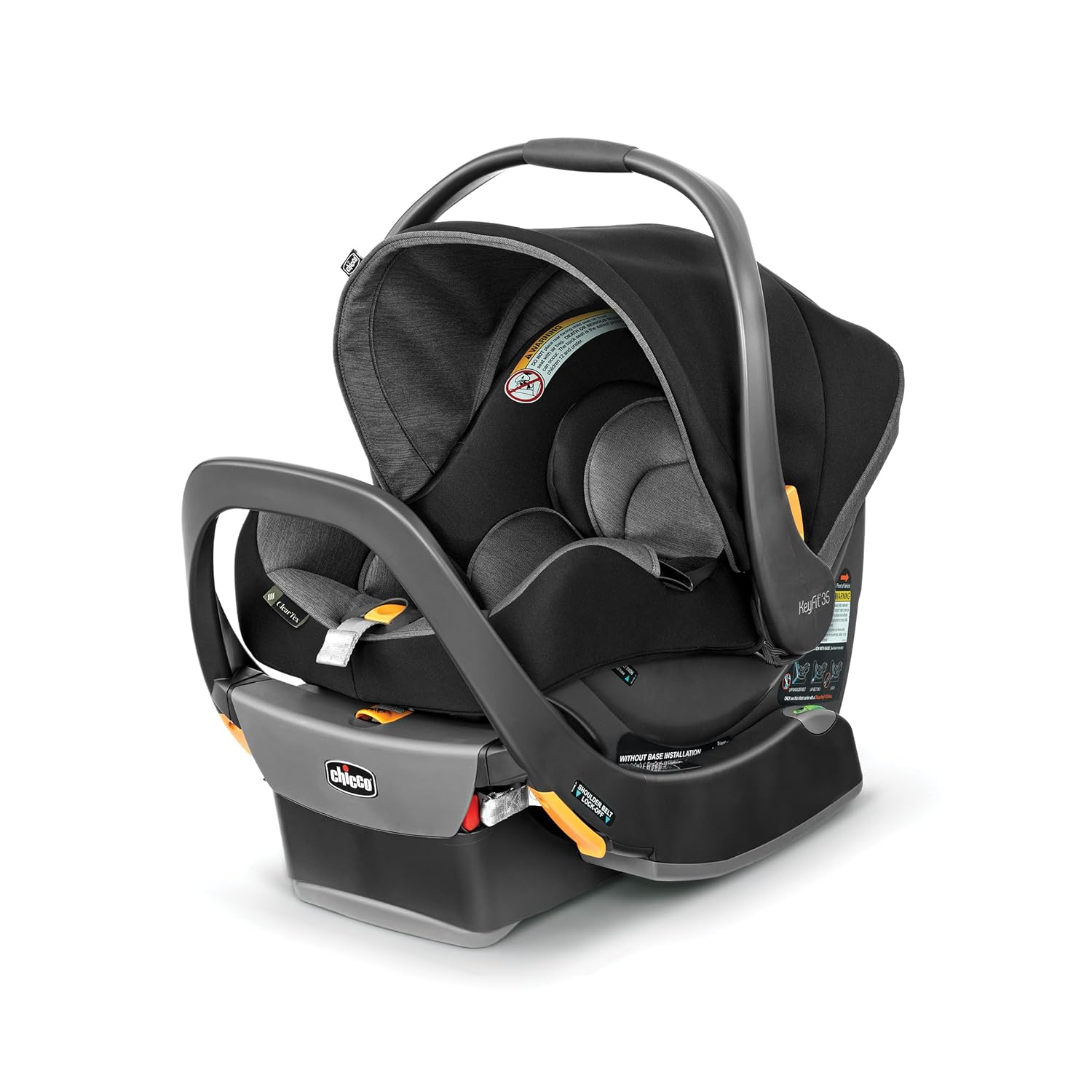
The Chicco KeyFit 35 is a popular choice among parents and experts alike for its excellent balance of safety, ease of use, and comfort. Designed for babies from birth up to 35 pounds, it provides an exceptionally secure and straightforward installation process using either the vehicle’s seat belt or the LATCH system.
Key Features:
SuperCinch® tightener system: Enables a secure fit with minimal effort
ReclineSure™ leveling foot and RideRight™ bubble indicators: Help ensure proper seat angle and positioning every time
5-point harness system: No-rethread design makes adjustments quick as your baby grows
Anti-rebound bar: Enhances stability during rear-facing use and reduces rotation in the event of a crash
Removable infant insert: Provides extra support for newborns and smaller babies
Compatible with many strollers: Easily transitions into a travel system
This seat offers exceptional head and neck support, and its shell is lined with energy-absorbing EPS foam to reduce crash force transmission. The KeyFit 35 is particularly well-suited for parents who want reliable safety and simplicity in daily use, including seamless transitions in and out of the car.
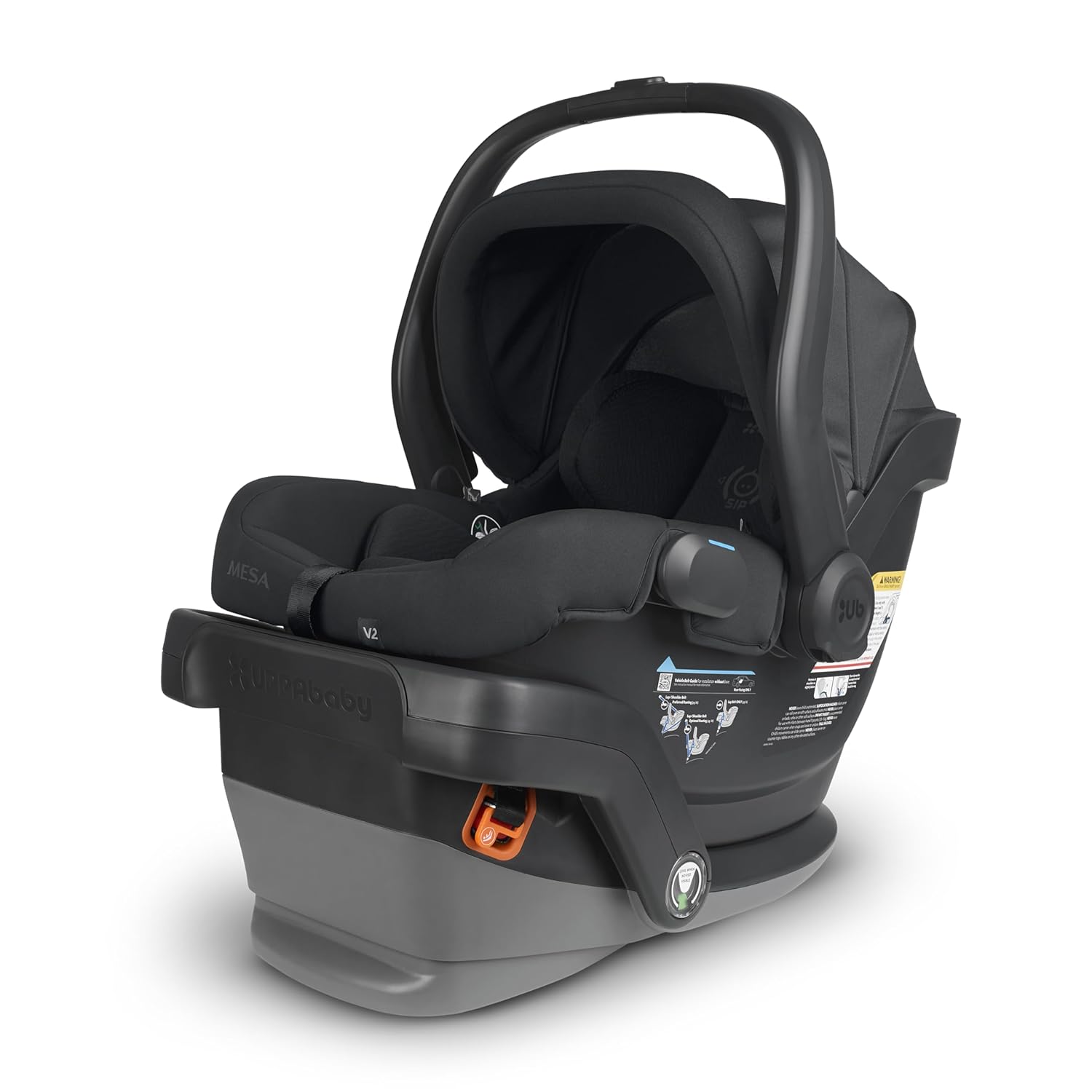
The Mesa V2 is a premium rear-facing infant seat known for its high safety scores, environmentally friendly design, and seamless integration with UPPAbaby strollers. It features a unique SMARTSecure™ system that uses tightness indicators and self-retracting LATCH connectors for foolproof installation.
Key Features:
SMARTSecure™ system with visual indicators: Confirms correct installation with green/red feedback
EPP energy-absorbing foam and side impact protection: Offer advanced head and torso support
No-rethread harness and adjustable headrest: Allows quick resizing as your baby grows
Fabric options free of flame-retardant chemicals: Prioritizes both safety and health
Integrated hideaway canopy: Offers UPF 25+ sun protection
The Mesa V2 combines thoughtful design with high-grade materials, making it a standout for parents who want convenience without compromising safety. Its compatibility with UPPAbaby’s travel system adds an extra layer of practicality, especially for families on the go.
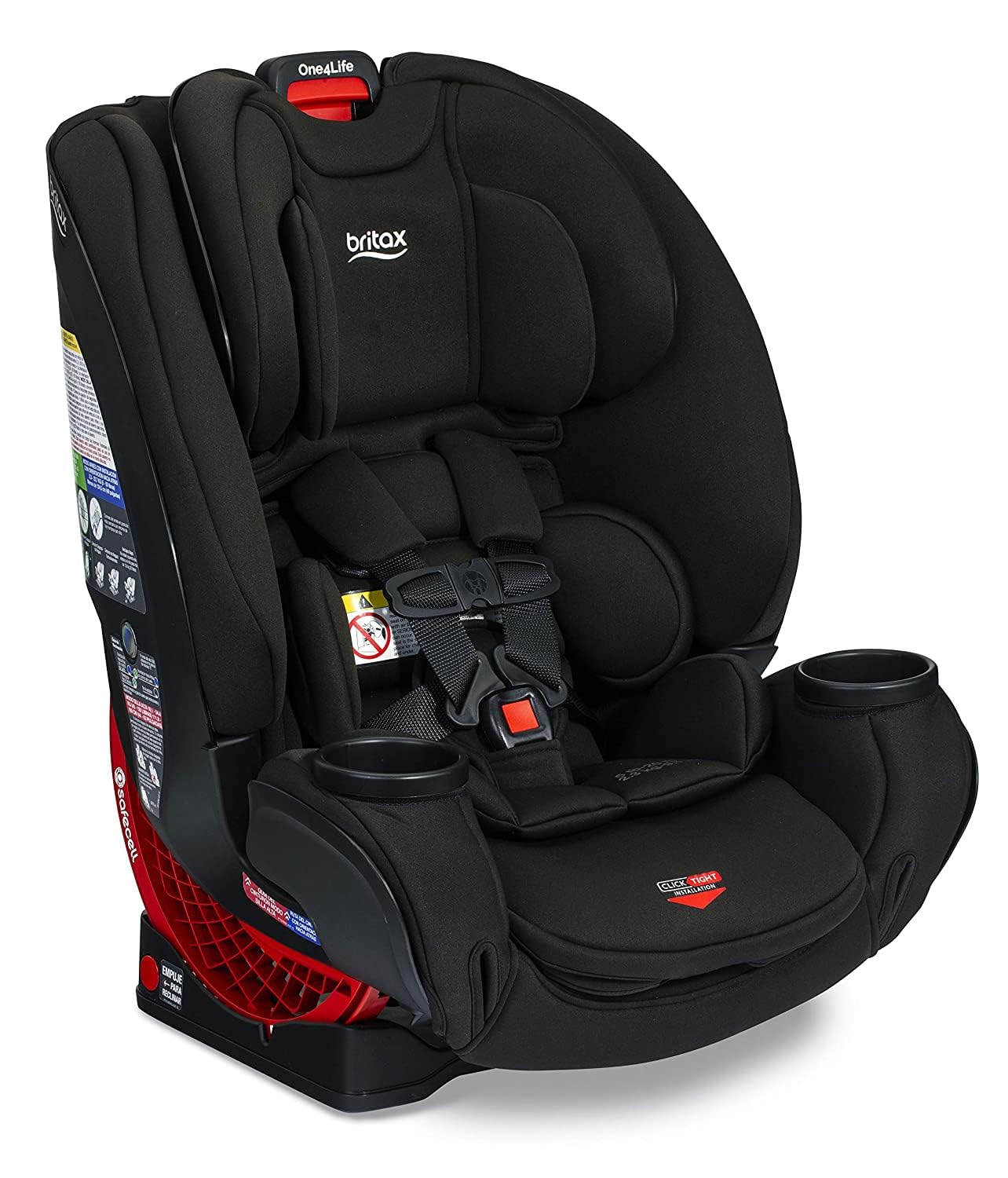
The Britax One4Life is engineered to provide long-term use—starting as a rear-facing seat, transitioning to forward-facing, and finally converting into a high-back booster. Its ClickTight® installation system is one of the easiest and most secure on the market, making it especially useful for families who move the seat between cars or want reassurance during installation.
Key Features:
ClickTight® system: Uses the vehicle’s seat belt for a rock-solid, tool-free install
Steel frame and crumple zone base: Help absorb crash forces and minimize movement
Two layers of side-impact protection: Reinforced shell and foam-lined headrest enhance safety
15-position headrest and 9 recline settings: Adjusts as your child grows, ensuring both comfort and fit
Removable, machine-washable cover: Designed with cooling channels and ventilation for longer rides
This seat offers extended rear-facing up to 50 pounds and converts to a booster for use up to 120 pounds. With its premium safety features, rugged construction, and easy installation, the One4Life provides a long-lasting, high-protection solution for growing children.
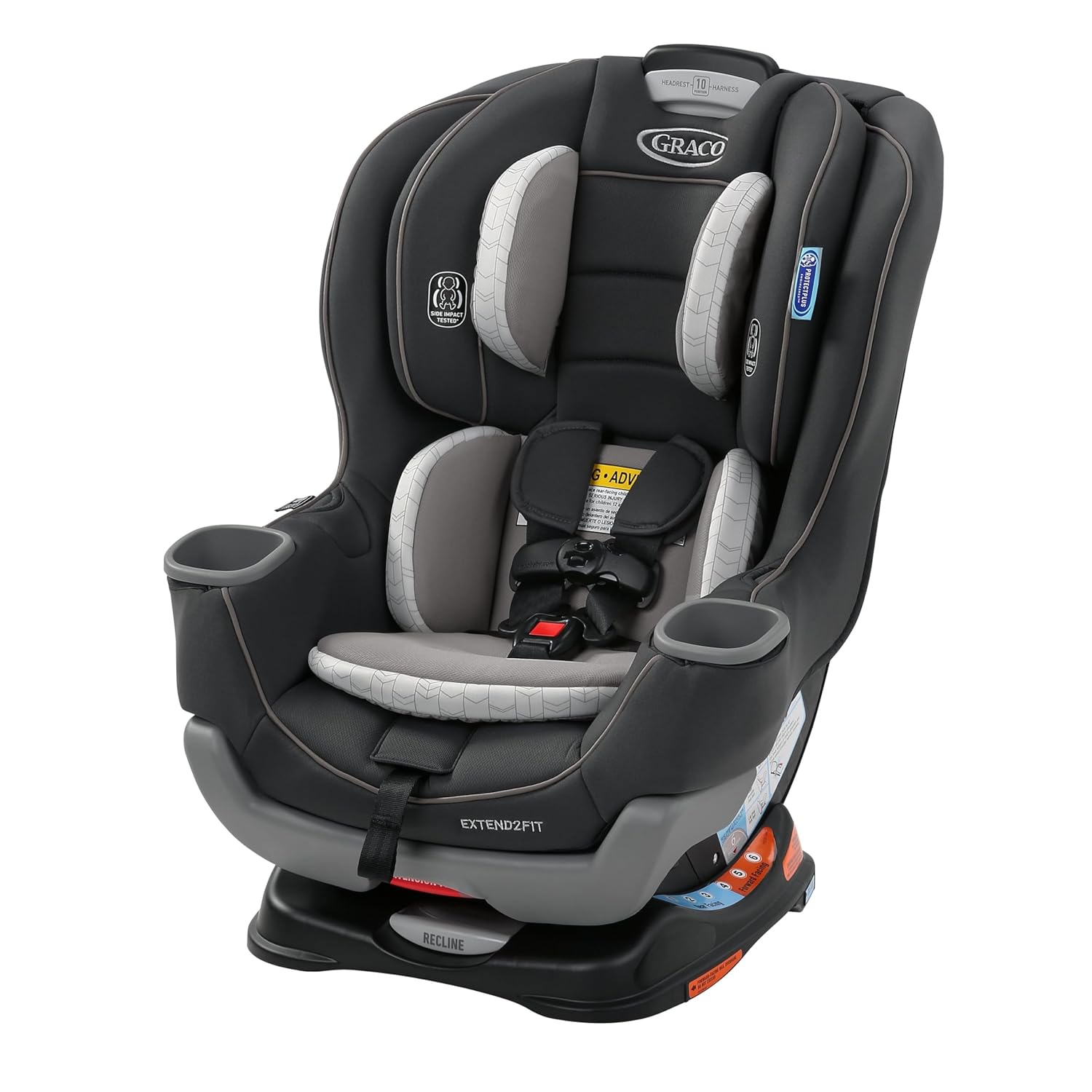
The Graco Extend2Fit is a top-rated convertible car seat praised for its extended rear-facing capabilities, compact footprint, and user-friendly design. Unlike many seats in its category, it supports rear-facing use up to 50 pounds, encouraging safer seating for toddlers well beyond infancy.
Key Features:
4-position extendable footrest: Provides up to 5 inches of additional legroom for rear-facing comfort
Steel-reinforced frame: Offers strength and durability for long-term use
10-position adjustable headrest: Grows with your child
Easy-to-read level indicator: Simplifies achieving the correct recline angle
InRight™ LATCH system: Enables a one-second attachment for quick and secure installation
Integrated cup holders: Built-in convenience for snacks and drinks on the go
The Extend2Fit’s space-saving design makes it a good fit for smaller vehicles while still offering generous room for a growing child. It’s widely recommended for parents seeking maximum safety during the crucial rear-facing stage, along with the flexibility to transition into forward-facing use later on.

The Clek Oobr is a high-performance booster seat built with a rigid metal substructure, advanced side-impact protection, and premium comfort features. It converts from a high-back to a backless booster, adapting as your child grows while maintaining strong safety performance throughout.
Key Features:
Rigid LATCH system: Keeps the seat securely anchored to the vehicle at all times
Magnesium frame: Increases structural integrity during a crash
Energy-absorbing foam layers: Reduce the force of impact during collisions
Reclining seat back: Supports rest and comfort, especially on long drives
GREENGUARD Gold Certified materials: Free of harmful chemicals and low in emissions
Detachable backrest: Allows conversion to a backless booster when needed
This booster is an excellent choice for parents who value both safety and style. Its rigid construction, combined with thoughtful ergonomic design and chemical-conscious materials, makes it especially well-suited for long-term booster use.
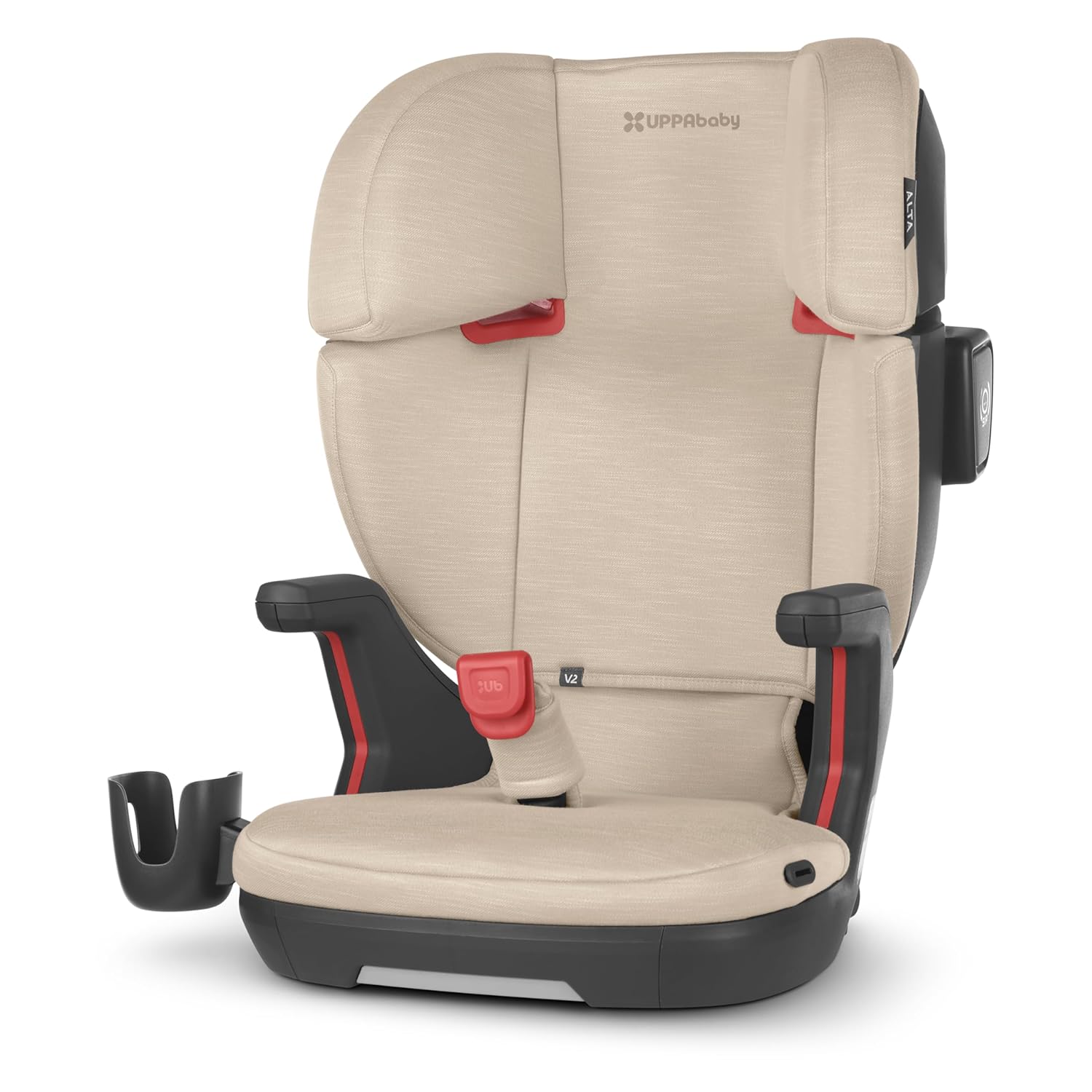
The Nuna AACE is a thoughtfully designed booster that grows with your child in multiple dimensions. Unlike standard boosters, it features a 3D growth™ system that adjusts not just the height, but also the shoulder width and seat depth—offering a tailored fit through every growth stage.
Key Features:
3D growth™ system: Simultaneously adjusts headrest height, shoulder width, and seat depth
Side impact protection pods: Extend outward for extra crash absorption
Energy-absorbing foam: Provides enhanced protection around the head and torso
Reclining backrest: Accommodates different vehicle seat angles
Removable, washable seat fabric: Ensures cleanliness and freshness
Lower anchor connectors: Help keep the booster securely in place even when unoccupied
The Nuna AACE offers a luxurious level of safety, adaptability, and comfort, making it a practical and secure option for older children who have outgrown forward-facing harness seats. It performs exceptionally well in independent safety tests and meets international safety standards.
All the models listed above were chosen based on the following essential criteria:
Compliance with current safety regulations such as FMVSS 213, R129, or ECE R44/04
Excellent performance in independent crash tests by organizations like NHTSA, Consumer Reports, and ADAC
Ease of installation—whether through LATCH, seatbelt, or rigid connectors
Adjustability and comfort features for growing children
Material quality and chemical safety, including flame-retardant-free options
Positive long-term user reviews for durability, cleaning, and real-world use
Choosing a car seat is one of the most important safety decisions you’ll make for your child. Each of these models combines safety, design, and functionality to support your child through critical stages of growth. No matter which you choose, remember that proper installation and correct usage are just as important as the seat itself.
You’ve picked a top-rated car seat—great! But even the safest car seat in the world can fail to protect your child if it’s installed or used incorrectly. Unfortunately, studies show that over 50% of car seats are misused in ways that could reduce their effectiveness in a crash.
This section covers how to properly install a car seat, what tools and techniques to use, and the most frequent errors parents make—so you can avoid them from day one.
There are two main methods for installing a car seat. Both are safe when used correctly, but they are not meant to be used together unless the manufacturer specifically says so.
LATCH is a standardized system that allows you to install a car seat without using the vehicle’s seat belt.
Lower anchors: Small metal bars located in the seat bight (where the seat back and bottom meet)
Top tether (for forward-facing seats): A strap attached to the upper part of the car seat that clips to an anchor on the car’s back panel, floor, or seatback
Locate the vehicle’s lower anchor points (usually marked with a symbol).
Attach the car seat’s lower connectors to the anchors and tighten until the seat moves less than 1 inch side-to-side or front-to-back.
For forward-facing seats, always attach the top tether for added stability and to reduce head movement in a crash.
Use angle indicators or built-in levelers (if available) to set the correct recline for rear-facing seats.
Important Note: LATCH has weight limits. Check both your car seat and your vehicle manual. If your child plus the car seat exceeds the limit (usually around 65 lbs combined), switch to seatbelt installation.
This method uses the vehicle’s seat belt to secure the car seat. It is just as safe as LATCH when installed properly.
Route the belt through the correct belt path (rear-facing and forward-facing have different ones).
Buckle the belt and lock it by pulling the belt all the way out until it clicks, then feeding it back in to remove slack.
Press down on the car seat and tighten the belt until the seat moves less than 1 inch when pulled at the belt path.
For forward-facing seats, don’t forget to use the top tether anchor.
🛑 Most Common Installation Mistakes (and How to Fix Them)
Avoiding these errors can dramatically improve the safety of your child’s car seat in a collision.
❌ 1. Loose Installation
Problem: The seat shifts more than 1 inch when pulled at the base.
Fix: Apply pressure on the seat while tightening the belt or LATCH strap. Use your knee or hand to push down firmly.
❌ 2. Incorrect Harness Height
Rear-facing: Harness straps should be at or below the child’s shoulders.
Forward-facing: Harness straps should be at or above the shoulders.
Why it matters: Incorrect strap placement can allow excessive movement in a crash.
❌ 3. Loose Harness Straps
Problem: If you can pinch the strap between your fingers, it’s too loose.
Fix: Use the harness adjustment strap to pull snugly until the strap lies flat and tight against the child’s chest.
❌ 4. Chest Clip Mispositioned
Problem: Clip too low on the abdomen or too high near the neck.
Fix: Position the chest clip at armpit level to keep the harness in place during impact.
❌ 5. Using Bulky Coats or Blankets
Problem: Padding between the harness and your child’s body prevents a snug fit.
Fix: Use thin, fitted clothing and cover your child with a blanket after they’re buckled in.
❌ 6. Turning Forward-Facing Too Soon
Problem: Many parents switch to forward-facing at 1 year, but experts now recommend rear-facing as long as possible.
Fix: Keep your child rear-facing until at least 2 years old, and ideally until they reach the rear-facing weight/height limit of the seat (often up to 50 lbs or 105 cm).
❌ 7. Incorrect Recline Angle (Rear-Facing Seats)
Problem: Seat is too upright, causing baby’s head to flop forward, risking airway blockage.
Fix: Use built-in recline adjusters and level indicators. The angle is especially important for newborns.
❌ 8. Not Using the Top Tether (Forward-Facing)
Problem: Some parents forget to connect the top tether, which is essential.
Fix: Always use the top tether when installing a forward-facing seat to reduce forward movement in a crash.
❌ 9. Installing the Car Seat in the Front Seat
Problem: The front seat is unsafe due to airbag deployment risks.
Fix: Always place the car seat in the back seat, ideally in the center position when available.
✅ Read Both Manuals: Always follow both the car seat manual and your vehicle manual—they offer specific guidance for proper use.
✅ Check Fit: Make sure the car seat fits your specific vehicle. Some car seats are better suited for smaller or larger cars. Use the manufacturer’s fit guide online.
✅ Use a Pool Noodle or Towel (if allowed): For rear-facing recline, a rolled towel or foam noodle can be placed under the base (if permitted by the car seat manufacturer).
✅ Do the Inch Test: After installing, grab the seat at the belt path and try to move it side-to-side and front-to-back. It shouldn’t move more than 1 inch.
✅ Visit a Car Seat Technician: Certified Child Passenger Safety Technicians (CPSTs) offer free or low-cost inspections. They can check your install, demonstrate adjustments, and answer questions.
Find a technician or inspection station at:
[EU]: Local road safety programs or certified retailers often offer checks
Even if you installed the seat perfectly, it’s important to check it regularly, especially as your child grows.
🔁 Recheck harness fit every few weeks
📏 Monitor weight/height to know when it’s time to transition
🔄 Inspect for loose parts, frayed straps, or worn-out padding
🧼 Clean only as directed by the manufacturer—harsh chemicals can weaken materials
📅 Check expiration date on the label (typically 6–10 years from manufacture)
Choosing the right baby car seat is one of the most important safety decisions you’ll make as a parent. It’s not just about meeting legal requirements—it’s about providing your child with the highest level of protection every time you hit the road.
By understanding the different types of car seats, knowing when to transition from one stage to the next, and learning how to install and use the seat properly, you’re taking powerful steps toward keeping your child safe. Investing time in researching safety standards, comparing crash test ratings, and selecting a seat that fits both your child and your vehicle can make a life-saving difference in the event of a crash.
The car seats featured in this guide were selected for their outstanding safety records, parent-approved features, and long-term value. However, even the best seat can only perform to its full potential if it’s installed correctly and adjusted to fit your child as they grow. Regular checks, proper harness use, and correct positioning are just as crucial as the seat itself.
Remember, safety isn’t a one-time decision—it’s a continuous commitment. From the first ride home from the hospital to school drop-offs years later, your vigilance and care play the biggest role in your child’s protection.
So take a deep breath, use this guide as your roadmap, and choose confidently. You’re not just buying a car seat—you’re providing your child with the comfort, security, and peace of mind they deserve on every journey.